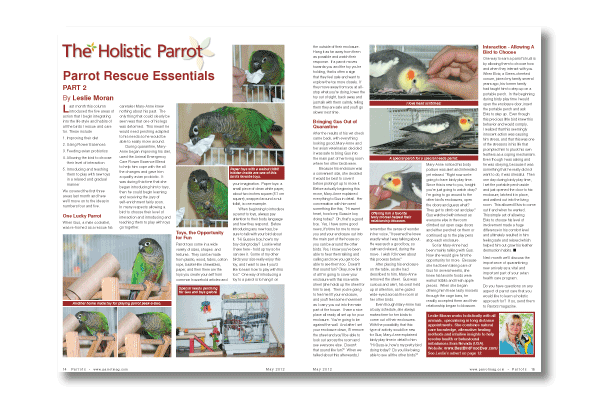
Parrot Rescue Essentials - Part 2
Last month this column introduced the five areas of action that I begin integrating into the life style and habits of all the birds I rescue and care for. These include
1. Improving their diet
2. Using Flower Essences
3. Feeding avian probiotics
4. Allowing the bird to choose their level of interaction
5. Introducing and teaching them to play with new toys in a relaxed and gradual manner
We covered the first three areas last month and here we’ll move on to the ideas in numbers four and five.
Read more in the magazine…
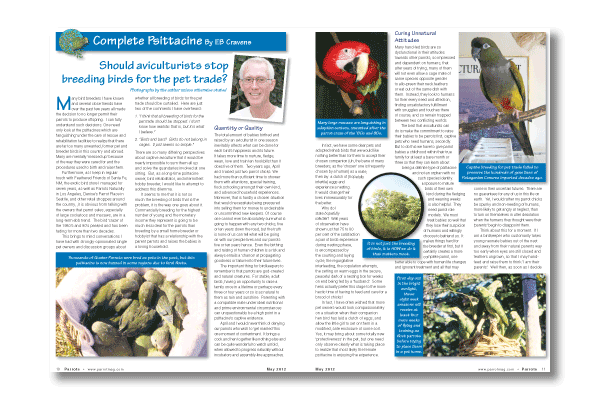
Should aviculturists stop breeding birds for the pet trade
Many bird breeders I have known and several close friends have over the past few years all made the decision to no longer permit their parrots to produce offspring. I can fully understand such decisions. One need only look at the psittacines which are 'languishing' under the care of rescue and rehabilitation facilities to realize that there are far too many unwanted, former pet and breeder birds in this country and abroad. Many are mentally 'messed up' because of the way they were cared for and the procedures used to birth and raise them.
Furthermore, as I keep in regular touch with Feathered Friends of Santa Fe, NM, the exotic bird store I managed for seven years, as well as Parrots Naturally in Los Angeles, Denise’s Parrot Place in Seattle, and other retail shoppes around the country, it is obvious from talking with the owners that parrot sales, especially of large cockatoos and macaws, are in a long-term ebb trend. The bird 'craze' of the 1980’s and 90’s peaked and has been fading for more than two decades.
Read more in the magazine…
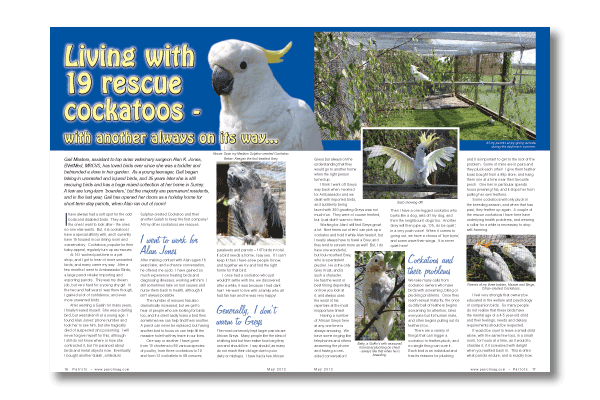
- with another always on its way…
Gail Masters, assistant to top avian veterinary surgeon Alan K. Jones, BVetMed, MRCVS, has loved birds ever since she was a toddler and befriended a dove in her garden. As a young teenager, Gail began taking in unwanted and injured birds, and 25 years later she is still rescuing birds and has a huge mixed collection at her home in Surrey. A few are long-term ‘boarders,’ but the majority are permanent residents, and in the last year, Gail has opened her doors as a holiday home for short-term stay parrots, when Alan ran out of room!
I have always had a soft spot for the odd bods and disabled birds. They are the ones I want to look after - the ones no-one else wants. But, it is cockatoos I have a special affinity with, and I currently have 19 housed in our dining room and conservatory. Cockatoos, popular for their baby-appeal, regularly turn up as rescues.
At 16 I worked part-time in a pet shop, and I got to hear of more unwanted birds, and many came my way. After a few months I went to Ambassador Birds, a large parrot retailer importing and exporting parrots. This was my dream job, but very hard for a young shy girl. In the two and half years I was there though, I gained a lot of confidence, and even more unwanted birds.
Read more in the magazine…
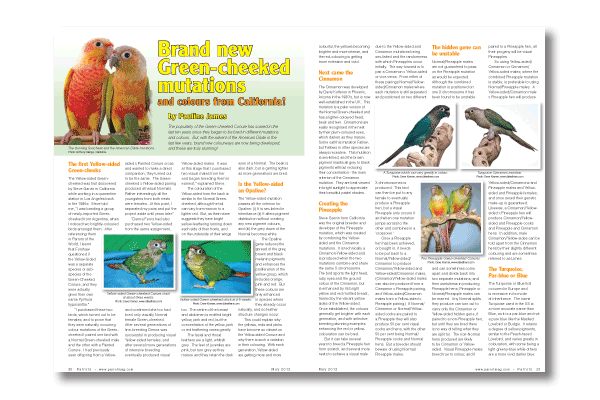
and colours from California!
by Pauline James
The popularity of the Green-cheeked Conure has soared in the last ten years since they began to be bred in different mutations and colours. But, with the advent of the American Dilute in the last few years, brand new colourways are now being developed, and these are truly stunning!
The first Yellow-sided Green-cheeks
The Yellow-sided Green-cheeked was first discovered by Steve Garvin in California while working in a quarantine station in Los Angeles back in the 1980s. Steve told me, “I was banding a group of newly-imported Green-cheeked from Argentina, when I noticed two brightly-coloured birds amongst them. After referencing them in Parrots of the World, I learnt that Forshaw questioned if the Yellow-Sided was a separate species or sub-species of the Green-Cheeked Conure, and they were actually given their own name Pyrrhura hypoxantha.”
Read more in the magazine…
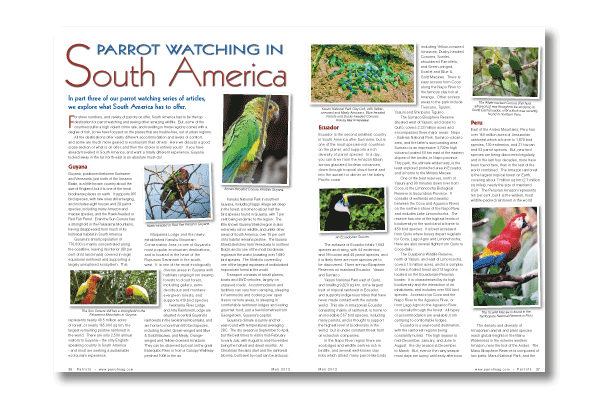
In part three of our parrot watching series of articles, we explore what South America has to offer.
For sheer numbers, and variety of parrots on offer, South America has to be the top destination for parrot watching and seeing other amazing wildlife. But, some of the countries suffer a high violent crime rate, and travelling in these regions comes with a degree of risk, so we have focused on the places that are trouble-free, out of urban regions.
All the destinations offer vastly different accommodation and levels of comfort, and some are much more geared to ecotourism than others. Here we discuss a good cross-section of what is on offer, and then the choice is entirely yours! If you have already travelled in South America, and want a totally different experience, Guyana tucked away in the far north-east is an absolute must-do!
Read more in the magazine…





